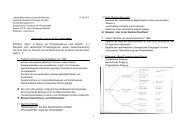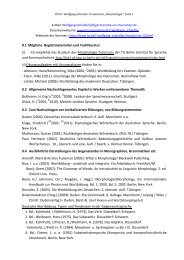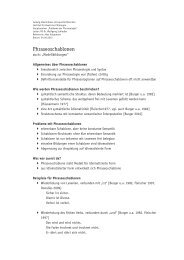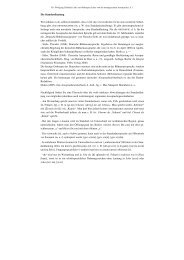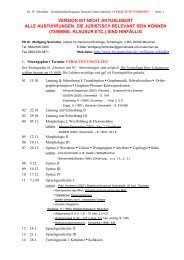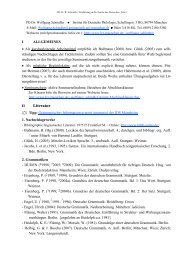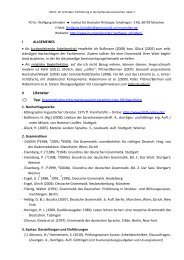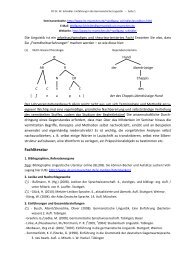Chapter 18 Lexical Functions: Description of Lexical Relations in a ...
Chapter 18 Lexical Functions: Description of Lexical Relations in a ...
Chapter 18 Lexical Functions: Description of Lexical Relations in a ...
You also want an ePaper? Increase the reach of your titles
YUMPU automatically turns print PDFs into web optimized ePapers that Google loves.
—<strong>Chapter</strong> <strong>18</strong>. <strong>Lexical</strong> <strong>Functions</strong>— 22<br />
obvious where the l<strong>in</strong>e has to be drawn. The solution depends on the semantic description <strong>of</strong> the<br />
value expression: if its mean<strong>in</strong>g <strong>in</strong>cludes the mean<strong>in</strong>g <strong>of</strong> the keyword, we have a degenerate LF;<br />
otherwise, it is a normal LF. Thus, I th<strong>in</strong>k that LOOK daggers [at N], bl<strong>in</strong>d DATE, ruddy CHEEKS,<br />
purple PROSE, puppy LOVE and white LIE are normal non-standard LFs: the mean<strong>in</strong>g <strong>of</strong> the collo-<br />
cate [daggers = (angrily or hatefully), bl<strong>in</strong>d = (with an unknown person), ruddy = (<strong>of</strong> reddish<br />
color), purple = (overornate and too elaborate), puppy = (occurr<strong>in</strong>g for the first time <strong>in</strong> very young<br />
people—quite <strong>in</strong>nocent), white = (told so as not to hurt someone)] does not <strong>in</strong>clude an explicit<br />
mention <strong>of</strong> the keyword and therefore semantically it is applicable to other LUs.<br />
Because <strong>of</strong> their rather specific mean<strong>in</strong>gs, non-standard LFs are more closely related to par-<br />
ticular languages (than standard LFs); that is, they are not universal. Because <strong>of</strong> that:<br />
• non-standard LFs cannot be logically predicted and organized <strong>in</strong>to an overall system;<br />
• non-standard LFs are very numerous, vary from language to language and extremely caprici-<br />
ous—they have to be discovered and collected empirically.<br />
The good news about non-standard LFs is, though, that they are very limited as to their<br />
doma<strong>in</strong>; they concern, as a rule, highly specialized situations. This greatly facilitates their ana-<br />
lysis and description.<br />
This chapter deals with the standard LFs only.<br />
2.5 Classification <strong>of</strong> <strong>Lexical</strong> <strong>Functions</strong><br />
For a better surveyability <strong>of</strong> LFs, they can be classified accord<strong>in</strong>g to different parameters;<br />
these classifications facilitate the task <strong>of</strong> the user and thus possess a pedagogical value. Five<br />
classification parameters <strong>of</strong> LFs will be considered here:<br />
• Paradigmatic vs. syntagmatic LFs.<br />
• Standard vs. non-standard LFs.<br />
• Simple vs. complex vs. mixed LFs.<br />
• Nom<strong>in</strong>al vs. verbal vs. adjectival vs. adverbial LFs.<br />
• Semantic group<strong>in</strong>gs <strong>of</strong> LFs.<br />
1. Paradigmatic vs. syntagmatic LFs. The opposition ‘paradigmatic vs. syntagmatic LFs’<br />
corresponds to to the opposition between paradigmatic and syntagmatic lexical correlates that has<br />
already been <strong>in</strong>troduced above, so that here it is sufficient to concentrate on a formal complica-<br />
tion:



![E-Mail: Wolfgang.Schindler[ätt]germanistik.uni-muenchen.de Web ...](https://img.yumpu.com/51590147/1/184x260/e-mail-wolfgangschindlerattgermanistikuni-muenchende-web-.jpg?quality=85)
